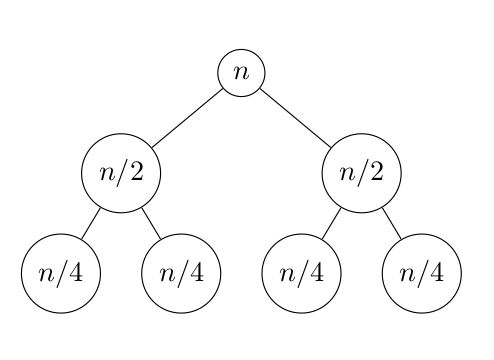MergeSort
05.06.2018
Paradigm: divide, conquer, combine.
Mergesort merges lists into atomic parts and then combines them back into a sorted list. Ex [5,3,10,2] → [5,3],[10,2] → [5],[3],[10],[2] → [3,5],[2,10] → [2,3,5,10]
The code for merge is
That is it merges two lists into one sorted:
And the code for merge-sort is
Ways to calculate time complexity on recursive methods
- Recursion trees (used to guess)
- Master method (used as a shortcut)
- Substitution (Universal)
Mergesort equation $$ T(n) = \begin{cases} T(1) & n = 1 \\ 2 T(n/2) + n & n > 1 \end{cases} $$
The recursion tree can be drawn for 3 levels as follows

Which seems like $O(n lg(n))$. Let's proof that by using the substitution method. So guess $c \cdot n \cdot lg(n)$. Base cases are $n = 2$ and $n = 3$ - we need to chose two to avoid relying on $n = 1$. $$ T(2) = 2 \cdot 1 + 2 \leq c \cdot 2 $$ and $$ T(3) = 2 \cdot 3/2 + 3 \leq c \cdot 3 $$ And for the induction step. Assume strongly that $T(n - 1) \leq c(n - 1)lg(n -1)$, that is for all $n_0 \leq n - 1$ and especially $n/2$. Now we get $$ T(n/2) \leq (n/2) \cdot c \cdot lg(n/2) \Rightarrow \\ 2T(n/2) \leq n \cdot c \cdot lg(n/2) \Rightarrow \\ 2T(n/2) + n \leq n \cdot c \cdot lg(n / 2) + n \Rightarrow \\ T(n) \leq n \cdot c(lg(n) - lg(2)) + n \Rightarrow \\ T(n) \leq c \cdot n \cdot lg - c \cdot n + n \leq c \cdot n \cdot lg(n) $$ for $c \geq 1$, and we are done.